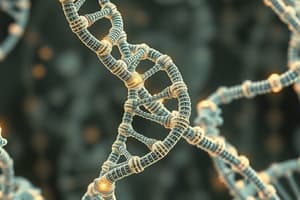Podcast
Questions and Answers
What are some examples of biotechnology, and how do they benefit society?
What are some examples of biotechnology, and how do they benefit society?
Examples of biotechnology include making bread, yoghurt, alcohol, gene therapy, CRISPR-Cas9, and creating transgenic species. They benefit society by improving food production, healthcare, and agricultural yields.
Explain the concept of natural selection and its role in evolution.
Explain the concept of natural selection and its role in evolution.
Natural selection is the process where organisms better adapted to their environment tend to survive and reproduce, leading to genetic changes in a population over generations. It plays a crucial role in evolution by driving speciation and biodiversity.
How does the fossil record provide evidence for the theory of evolution?
How does the fossil record provide evidence for the theory of evolution?
The fossil record demonstrates changes in species over time and provides chronological evidence of the progression and transition of life forms on Earth. It shows how present-day organisms have evolved from ancestral species.
Define speciation and describe the three steps involved in the process.
Define speciation and describe the three steps involved in the process.
Discuss how the study of the peppered moth supports the theory of natural selection.
Discuss how the study of the peppered moth supports the theory of natural selection.
What are the components of a nucleotide in DNA and how do they contribute to its structure?
What are the components of a nucleotide in DNA and how do they contribute to its structure?
Explain the purpose of mitosis and how it differs from meiosis.
Explain the purpose of mitosis and how it differs from meiosis.
How did Gregor Mendel's work with pea plants contribute to our understanding of inheritance?
How did Gregor Mendel's work with pea plants contribute to our understanding of inheritance?
Describe the relationship between alleles, genes, and chromosomes.
Describe the relationship between alleles, genes, and chromosomes.
What is the significance of protein synthesis and how can a point mutation affect this process?
What is the significance of protein synthesis and how can a point mutation affect this process?
Flashcards are hidden until you start studying
Study Notes
Structure of DNA
- DNA consists of nucleotides, which are the building blocks, composed of a sugar, phosphate, and nitrogenous base.
- Four nitrogenous bases in DNA: adenine (A), thymine (T), cytosine (C), and guanine (G).
- Base pairing rules: A pairs with T, and C pairs with G, maintaining the double helix structure.
- The DNA backbone is formed by the sugar and phosphate components of nucleotides.
Discovery of DNA Structure
- The double helix structure of DNA was identified by James Watson and Francis Crick, building on work from Rosalind Franklin and others.
DNA Replication
- Involves separating two DNA strands and using enzymes to build new complementary strands according to the template.
- DNA polymerase is crucial for synthesizing the new strands.
- Exact replication ensures genetic stability for organisms.
Eukaryotic Cell Organelles
- Key organelles include the nucleus (contains DNA), mitochondria (energy production), chloroplasts (photosynthesis), rough and smooth endoplasmic reticulum (protein synthesis and lipid production), ribosomes (protein synthesis), Golgi apparatus (modifying and packaging proteins), and lysosomes (digestion).
Chromosomes
- Structures made of DNA that carry genetic information, inherited from parents.
Eukaryotic Cell Cycle
- Phases include G1 (cell growth), S (DNA synthesis), G2 (preparation for mitosis), and M (mitosis).
Mitosis
- Purpose is to replicate somatic cells for growth and repair.
- Involves stages: prophase, metaphase, anaphase, and telophase, where chromosomes align, separate, and move to opposite poles.
Meiosis
- Process that creates gametes (sperm and ova), resulting in cells with half the chromosome number of somatic cells, crucial for sexual reproduction.
- Involves two divisions (meiosis I and meiosis II) and crossing over, enhancing genetic diversity.
Mitosis vs. Meiosis
- Mitosis: one division, produces two identical daughter cells.
- Meiosis: two divisions, producing four genetically diverse gametes.
Gregor Mendel and Inheritance
- Conducted experiments with pea plants, establishing foundational principles of inheritance, including dominant and recessive traits.
Genetics Terminology
- Allele: variant form of a gene.
- Gene: segment of DNA that codes for a trait.
- Phenotype: observable characteristics.
- Genotype: genetic makeup.
- Homozygous: identical alleles.
- Heterozygous: different alleles.
DNA and Genes
- DNA contains genes that encode alleles, which are located on chromosomes.
Inheritance Patterns
- Codominance: both alleles expressed equally.
- Incomplete dominance: blending of traits.
- Sex-linked inheritance: traits associated with genes on sex chromosomes.
Monohybrid Crosses
- Predict phenotypic and genotypic ratios for single traits through crosses.
Pedigrees
- Symbols in pedigrees help track inheritance patterns; can determine modes of inheritance.
Protein Synthesis
- Process by which cells create proteins, essential for function and structure.
- Involves transcription (DNA to mRNA) and translation (mRNA to amino acids).
Point Mutations
- Minor changes in DNA sequence can alter protein structure and function, affecting phenotype.
Biotechnology
- Branch of science involving technological applications of biology.
- Examples: bread and alcohol production, gene therapy, CRISPR technology, and creation of transgenic organisms.
- Advantages: medical advancements, agricultural benefits. Disadvantages: ethical concerns, ecological impacts.
Evolution
- Evidence from fossils shows organisms evolved over time, with new species arising.
- Definition: genetic changes in species leading to the emergence of new species over generations.
Natural Selection
- Mechanism of evolution where favorable traits increase in frequency.
- Variation exists within populations, influencing survival and reproduction.
Comparative Anatomy
- Homologous structures in vertebrate limbs indicate common ancestry.
- Studies of natural selection using examples like the peppered moth demonstrate adaptive changes.
Speciation and Biodiversity
- Speciation processes: variation, isolation, and selection contribute to biodiversity.
- Phylogenetic trees illustrate evolutionary relationships among species.
Human Evolution
- Comparison of human and ape skeletons provides insights into adaptations for bipedalism.
- Fossil records of Australopithecines inform on early human evolution and migration theories.
Studying That Suits You
Use AI to generate personalized quizzes and flashcards to suit your learning preferences.




